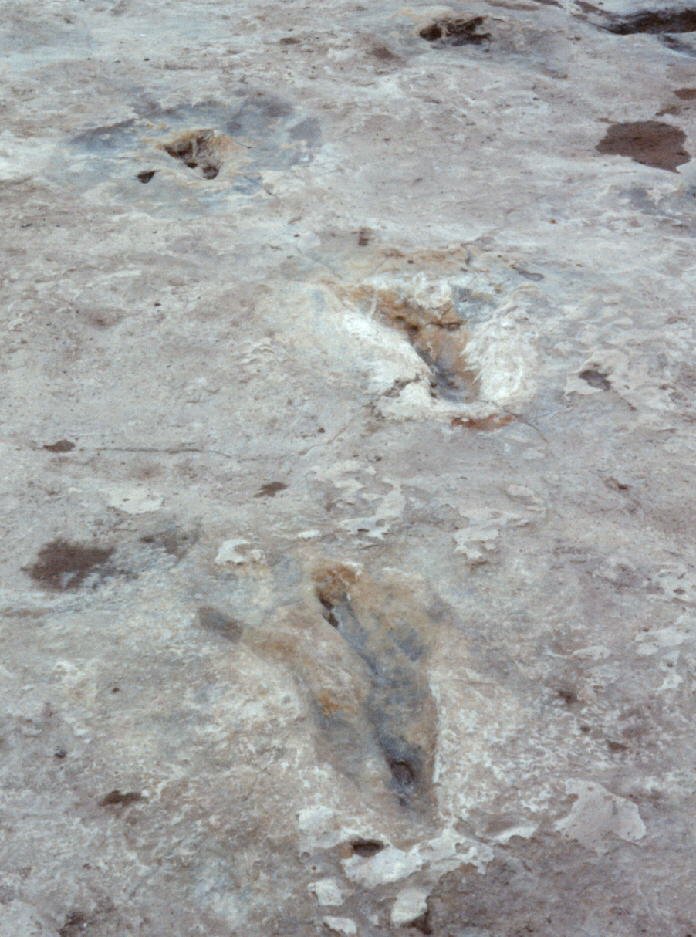
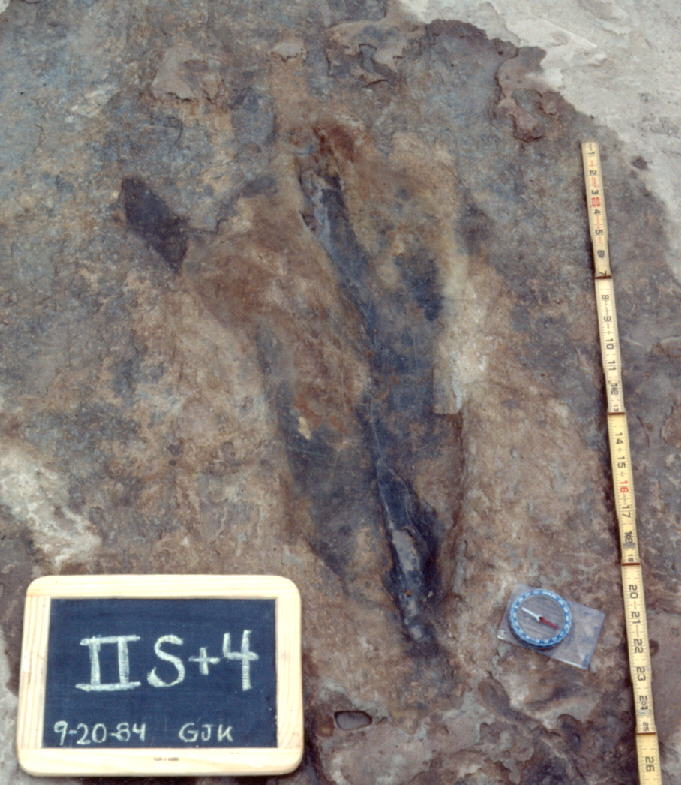
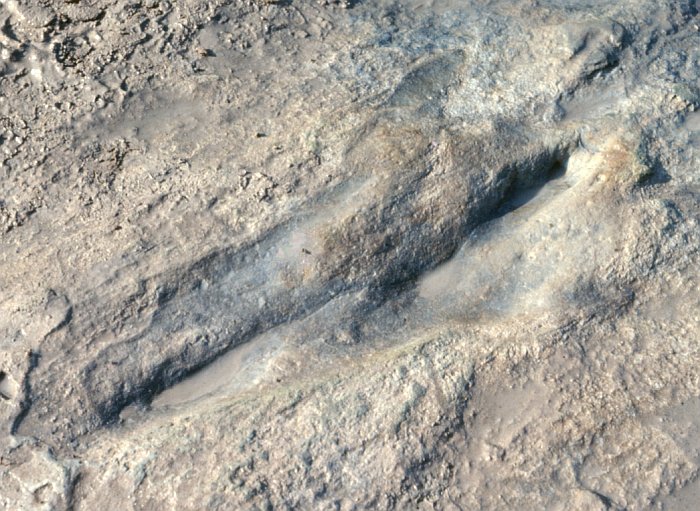
A. Western Portion of the Taylor Trail (track IIS+4 at bottom).
This on-line article is part of Kuban's Paluxy website
 |
 |
 |
|
Figure 1. Taylor Trail, 1984. A. Western Portion of the Taylor Trail (track IIS+4 at bottom). | Figure 1B. Track IIS+4, with surface moistened to bring out color contrast. In 1984 this track showed a combination of blue-grey and rust-brown color. | Figure 1C. Track IIS+4, photographed at a low, oblique angle to highlight the texture and shallow relief features. Note the clearly defined digit and metatarsal segment, with only slight topographic relief. |
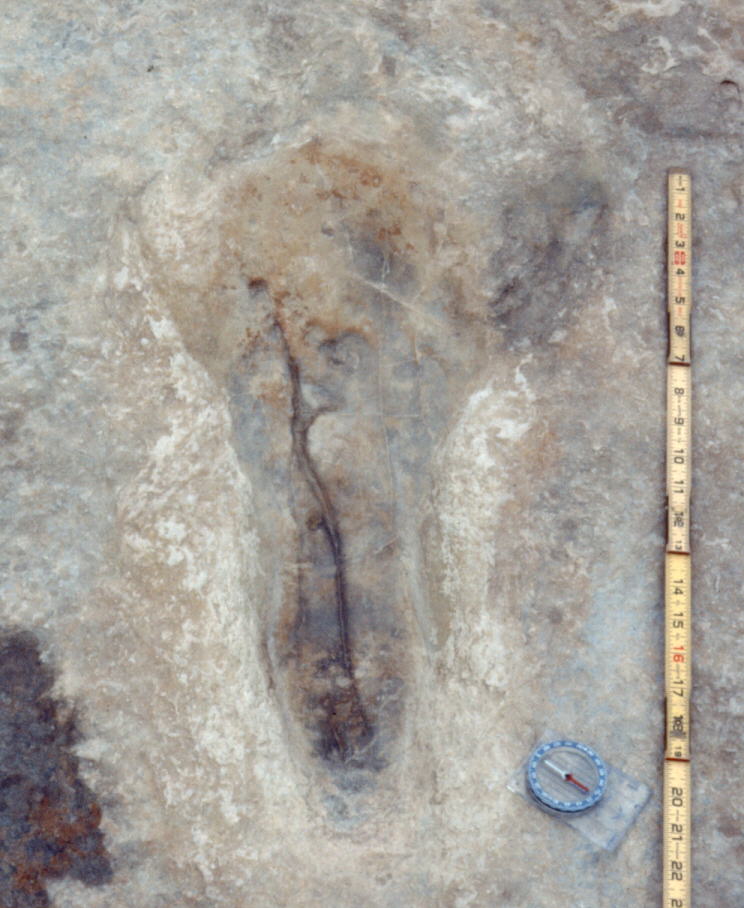 |
Figure 1D. Track IIS+3. This is perhaps the most human-like track in trail, but indications of dinosaurian digits are visible at the upper right and left of the track. Compare 1985 photos in Fig. 4. |
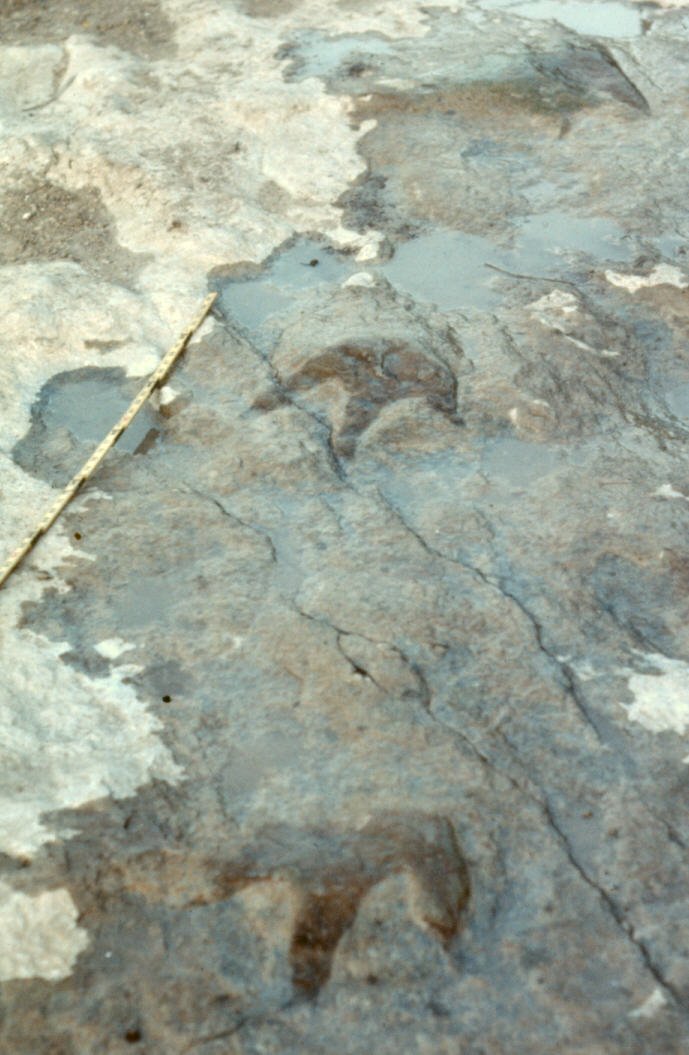 |
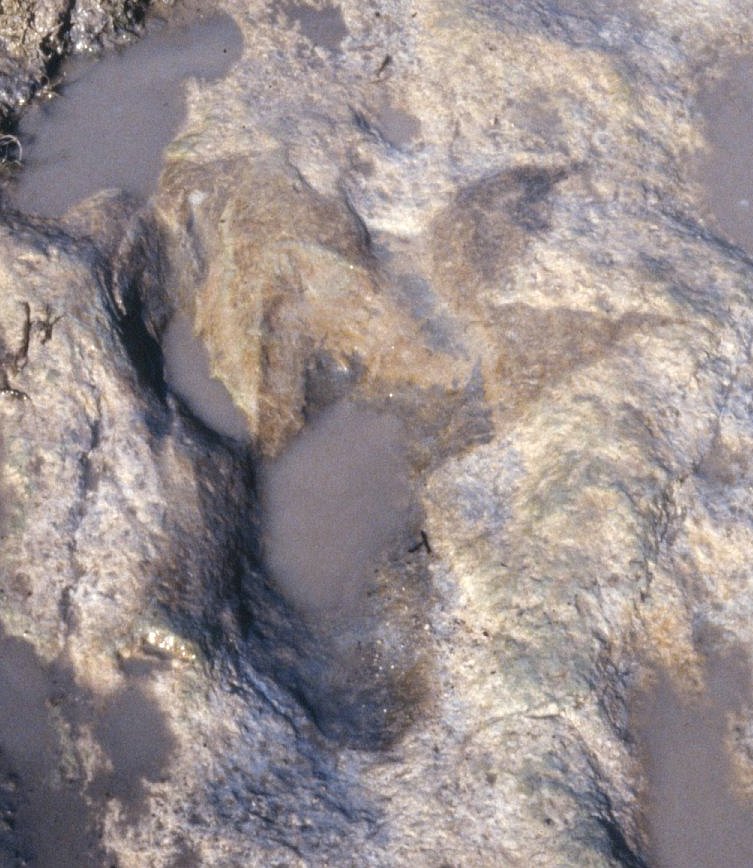 |
| Figure 2a. Trail R (track R3 at bottom). These tracks showed rust-brown coloration with vivid contrast with the surrounding substrate, and some positive relief (the limestone is evidently eroding around the infilling material). | Figure 2B. Two overlapping infilled metatarsal tracks: RY+5 and IIDW,-11. RY+5 progresses from lower left to upper right (showing two clear digits and little relief). IIDW,-11 progresses from lower left to upper left, and has indistinct digits. |
In 1984 a few tracks on the Taylor Site were largely or entirely rust-colored. These included a series of newly recognized, small, digitigrade, sharp-toed, tridactyl tracks named the R Trail, which showed slight positive relief (Fig. 2A). Also showing distinct rust-brown coloration in 1984 was track RY+5 and a track overlapping it, the latter showing clear dinosaurian digits delimited primarily by coloration (Fig. 2B).
The rust-brown portions of the tracks showed stronger contrast with the surrounding substrate than the blue-grey colorations, but both were easily visible when the track surface was well cleaned, and especially when the surface was clean and damp. The color-distinct material, where bluish, was noticed to be somewhat softer than the surrounding substrate, and had a slippery, claylike feel. However, where rust-brown the color-distinct material was at least as hard as the surrounding material, which might account for the raised relief tracks (the limestone might be eroding around the rust colored material).
Initially, I speculated that the color and texture distinctions may have been due to a pressure or compaction phenomenon; envisioned was a dinosaur walking on a firm substrate, making shallow depressions, but compacting the sediment under each step. The compacted areas might show a smoother texture, and perhaps weather differently than the surrounding rock, leading in time to the color contrast. However, further study of the tracks and core samples (discussed below) has largely discounted this idea, and provided much evidence that the color distinctions are primarily due to a secondary infilling of the original depressions with a fine-grained sediment. The blue-grey material evidently represents the main infilling sediment, and the rust color, where present, evidently represents oxidation of iron on the surface of the infilling material.
The infilling concept is consistent with the observation that some of the color-distinct material appears to have been removed from some tracks by erosion or other means. For example, track IIS+1 ( Fig. 3A ) has a deep hole at the anterior end, contrasting the relative shallowness of most other tracks in the trail. All of track IIS,-7 ( Fig. 3B ) is very deep, even though no track was observed at this spot when the site was first excavated. Creationist workers during the late 1970's related that they chiseled out "hard clay" from this spot, and considered the resulting cavity a "probe hole" rather than a track (Fields, 1980). However, the anterior end has a tridactyl shape, and evidently what the early workers really did (unknowingly) was remove the infilling material from an elongate dinosaur track.
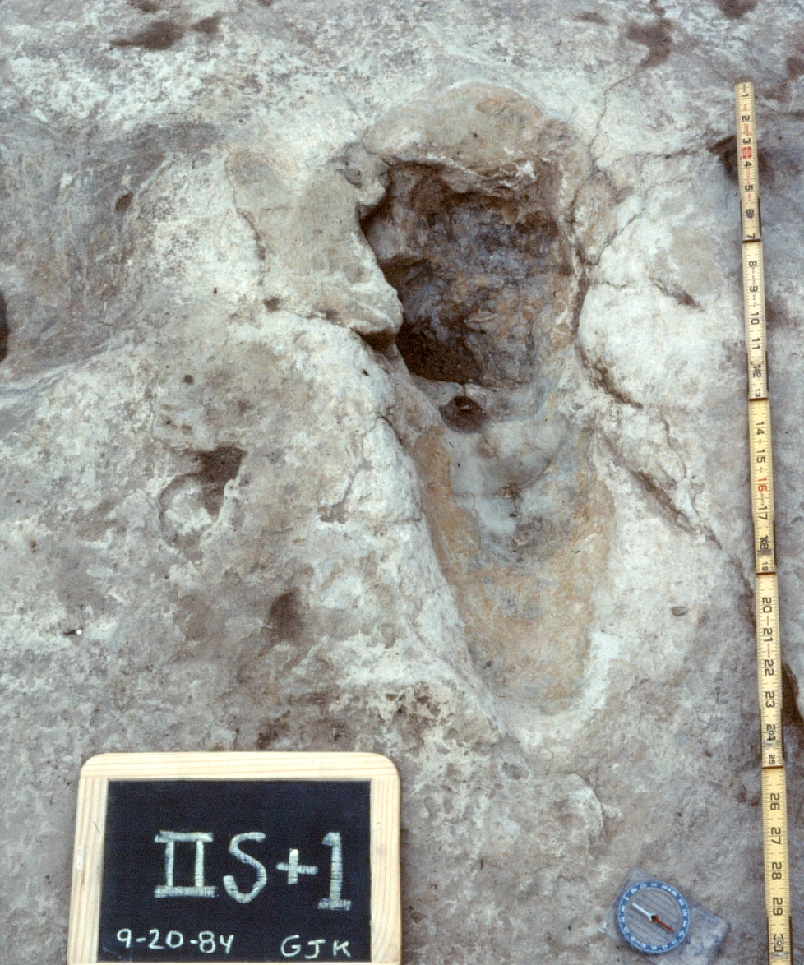 |
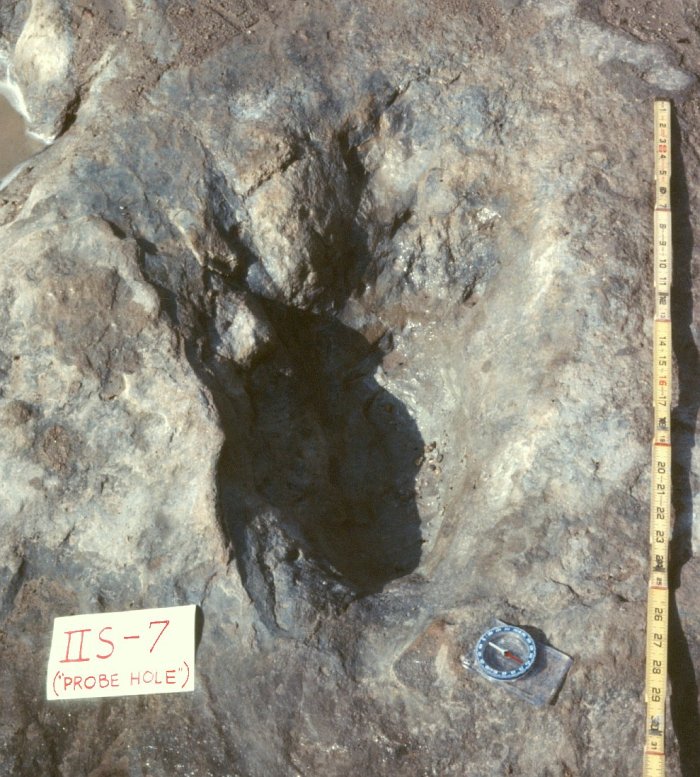 |
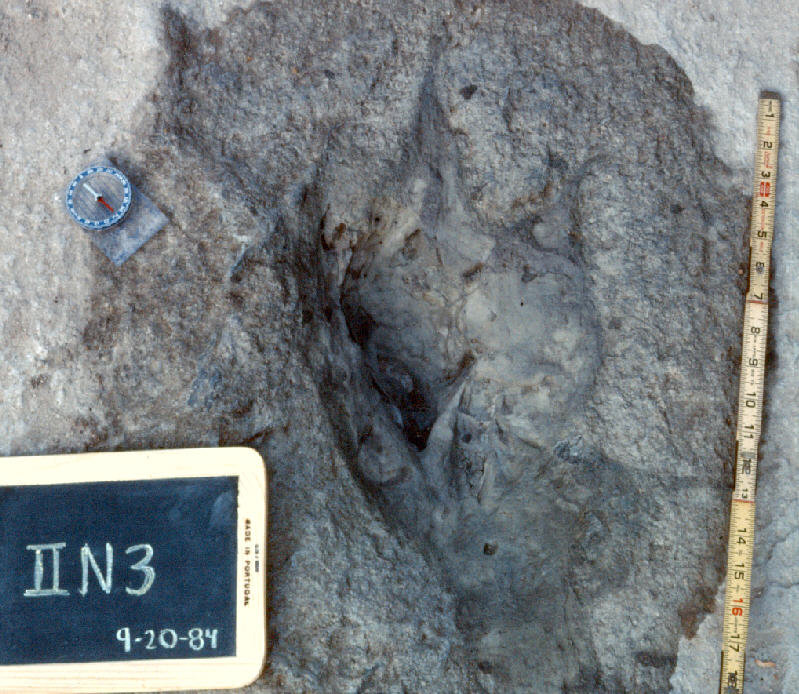 |
| Figure 3a. Taylor Trail track IIS+1, bearing a deep hole at the anterior end, where evidently a considerable amount of infilling has come out. | Figure 3b. Track IIS+1, called a "probe hole" by early creationst workers who removed "hard clay" (the infilling) from the spot. | Figure 3c. Turnage Trail track IIN3, a semi- elongate track with all blue-grey coloration, in a low area of the site. The oblong depression at the left prompted some to consider it human-like; however, on close inspection one can see color, texture and shallow relief features indicating a dinosaurian digit pattern. |
Among the trackways newly documented in 1984 by virtue of the color distinctions (besides the previously mentioned R Trail) was the A Trail, a long series of digitigrade, tridactyl tracks showing wide, well-rounded posteriors and short digits; this is one of the few trackways near Glen Rose that can be attributed reliably to an ornithopod dinosaur. Observed near Trail A, and progressing in the same direction, was Trail G, a short sequence of smaller but similarly shaped color-distinct tracks, perhaps representing a juvenile walking with an adult. Also discovered 1984 was Trail C, comprised of four small tridactyl tracks with blue-grey coloration and little depression; and an extension of the Giant Run (GR) Trail (another alleged "man" trail), which showed color distinctions clearly indicating dinosaurian digits. Other short trails and some isolated prints also were found which showed distinct coloration but little relief.
Unlike most tracks on the site, all of the large digitigrade tracks comprising the IID Trail ( Fig. 3B ) are very deep (most over 12 cm deep) and appear to contain little if any infilling material. Possible reasons for this are discussed further below.
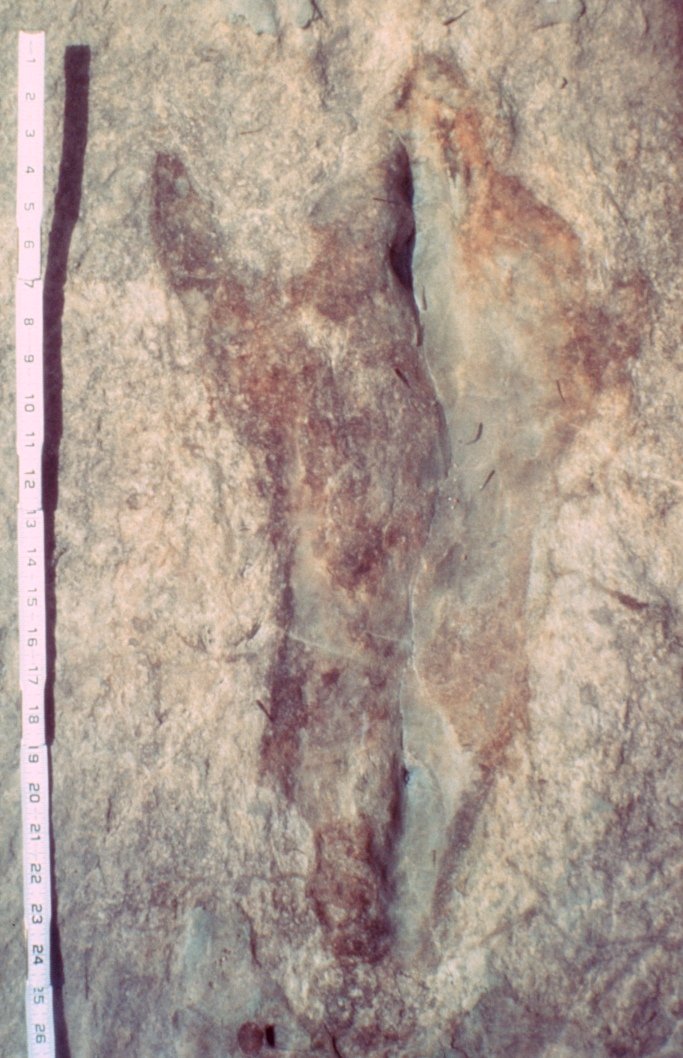 |
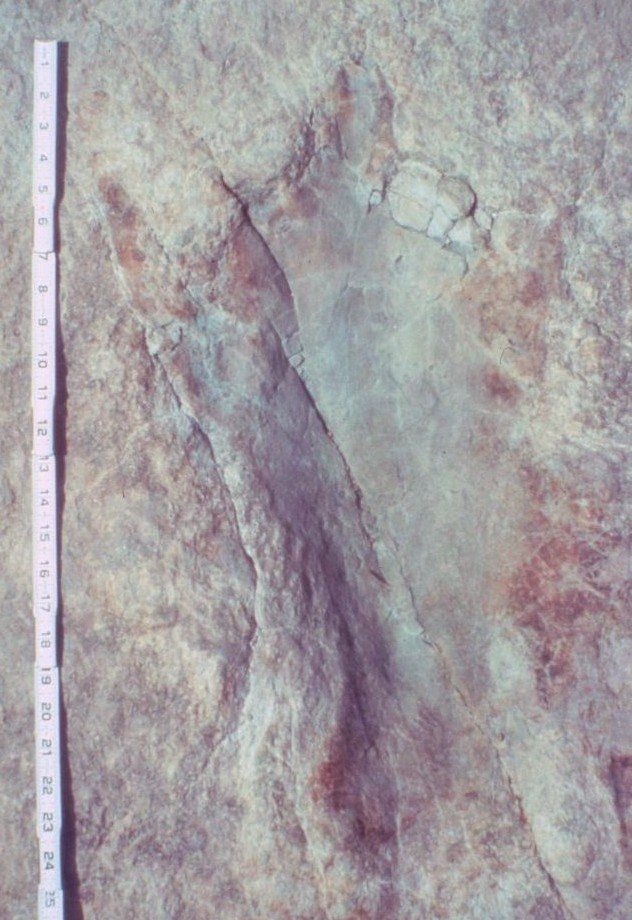 |
 |
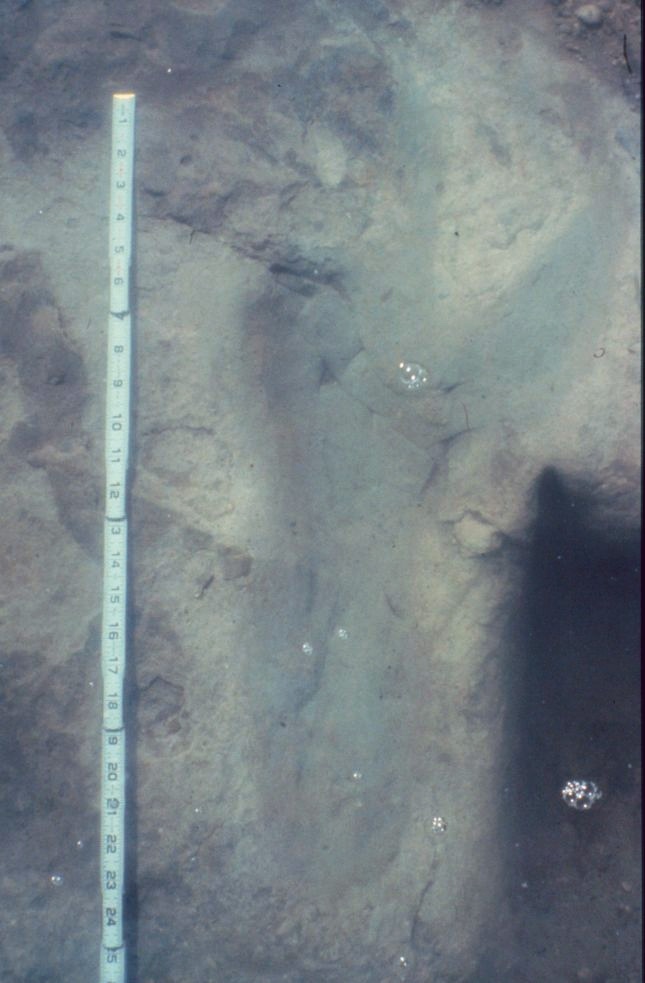 |
| Figure 4. Taylor Trail tracks under shallow water, 1985. A. Track IIS,+4 (at left) showing more rust-brown color and thus more vivid contrast than in 1984 (compare to figure 1). | Figure 4B. Track IIS,+2 showing rust-brown coloration at the highest parts of the track (the sides and digits) and blue-grey coloration in the deeper middle region. | Figure 4. C. Track IIS,+3 (a right). The rounded front of the track is evidently due to the way the mud was pushed up by the "ball" of the dinosaur's foot, and/or a wide pad at the base of the middle digit. | Figure 4D. Track IIS,-4 (a right), under several centimeters of water, showing all blue-grey coloration. The deep dinosaur track at right is IID7. |
Among newly observed tracks in 1985 was the extension of the IIDW Trail, which was formerly thought (based on its vague depressions) to be a short sequence of eroded digitigrade tracks, but which now shows color distinctions revealing it to be a long trail of large metatarsal tracks ( Fig. 6 ). The coloration patterns on some IIDW tracks are so distinct that in some cases sharp claw marks at the ends of the digits are clearly visible ( Fig. 6D ). IIDW tracks largely delimited by the colorations remain recognizable even where they cross deep erosional scours at the middle of the river ( Fig. 6C ), suggesting that the original track depressions (before infilling) were fairly deep (which is supported by other evidences, discussed later). Also found in 1985 were additional tracks in the Ryals Trail, including RY,-1, a digitigrade track with raised relief (Fig. 7).
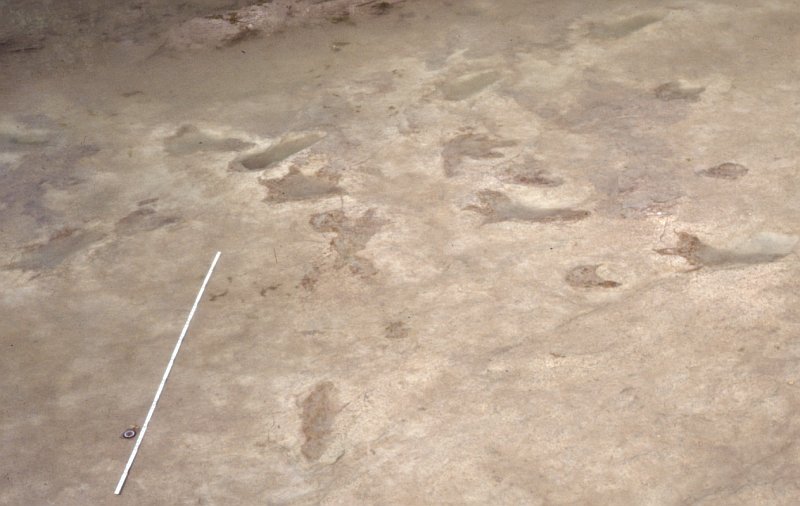 |
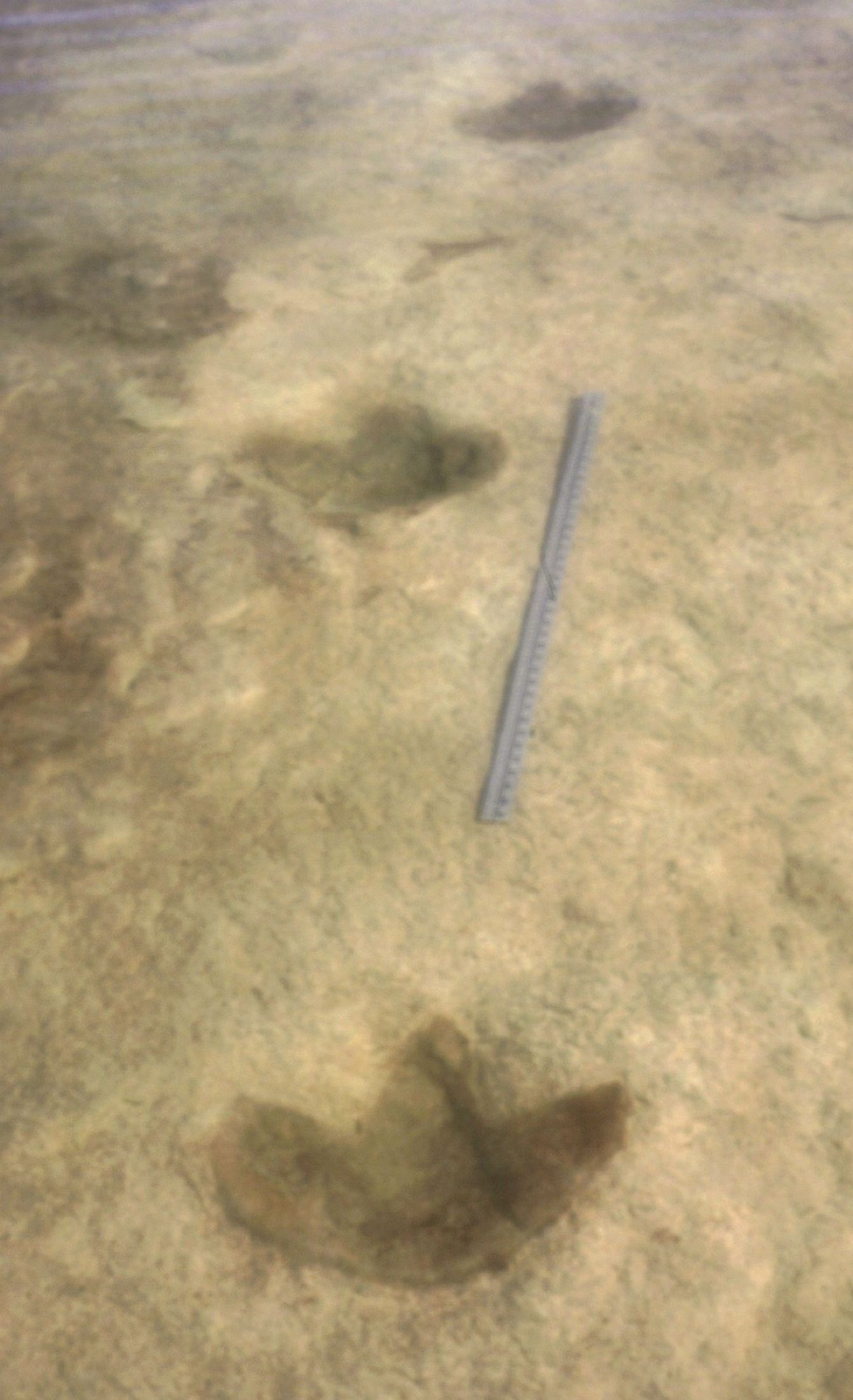 |
| Figure 5A. (left photo). The central, highest portion of the Taylor Site, under very shallow water, 1985. Most of the tracks in this area showed vivid rust-brown coloration in 1985. The Taylor (IIS) Trail (proceeding from upper right to middle left) intersects the Giant Run Trail (from lower left to top), the IIDW Trail (right to upper left), and Trail A (middle left to upper right). | Figure 5B. (right photo). Portion of Trail A, one of the few probable ornithopod trails in the Glen Rose area. |
In some cases small fissures or cracks in the substrate were
noticed to coincide with the coloration boundaries, evidently
representing places where the infilling material has separated
slightly from the outside material. In other places apparent
"infilled cracks" (delimited by coloration rather than
indentation) were observed; these evidently represent ancient
cracks in the original substrate which were infilled along with
the track depressions (see upper right of Fig. 6D). Some wider,
ill-defined areas of coloration outside the track borders were
also observed, and may represent residual infilling material.
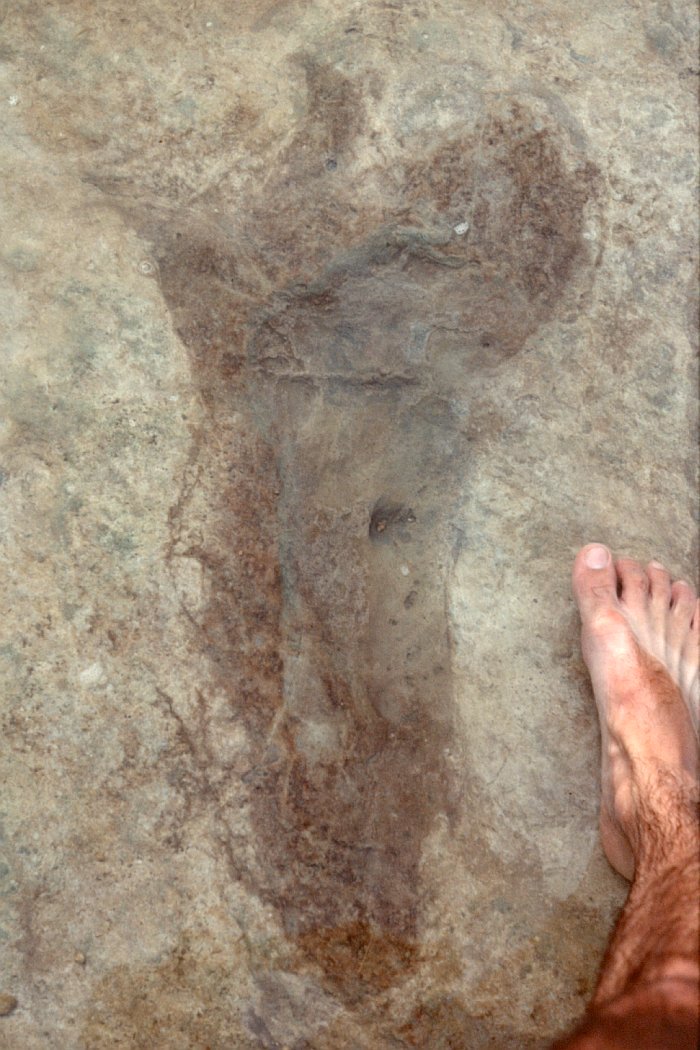 |
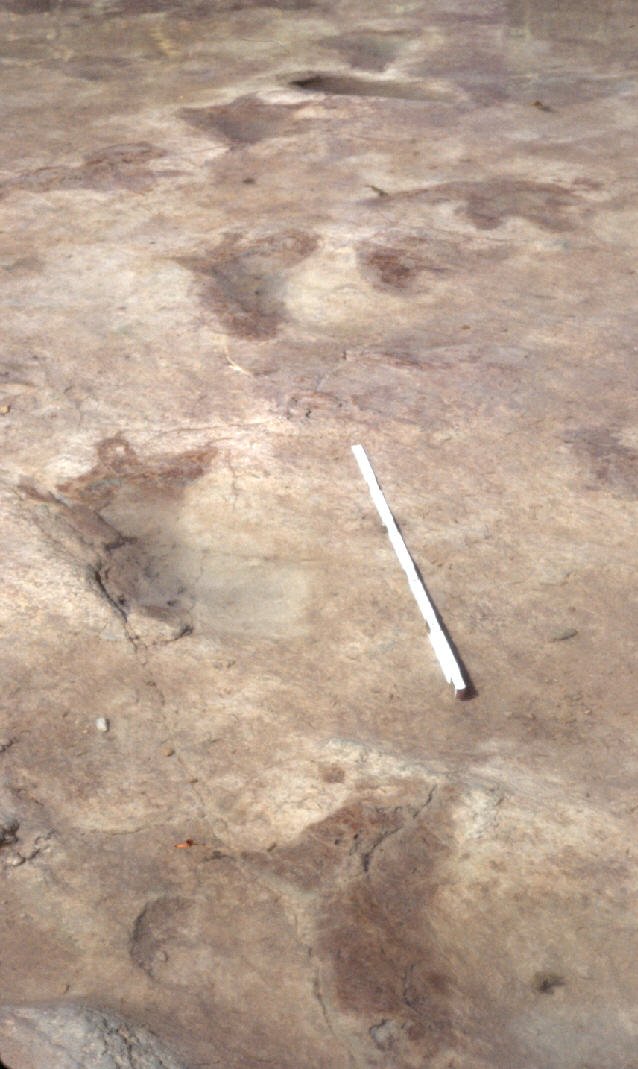 |
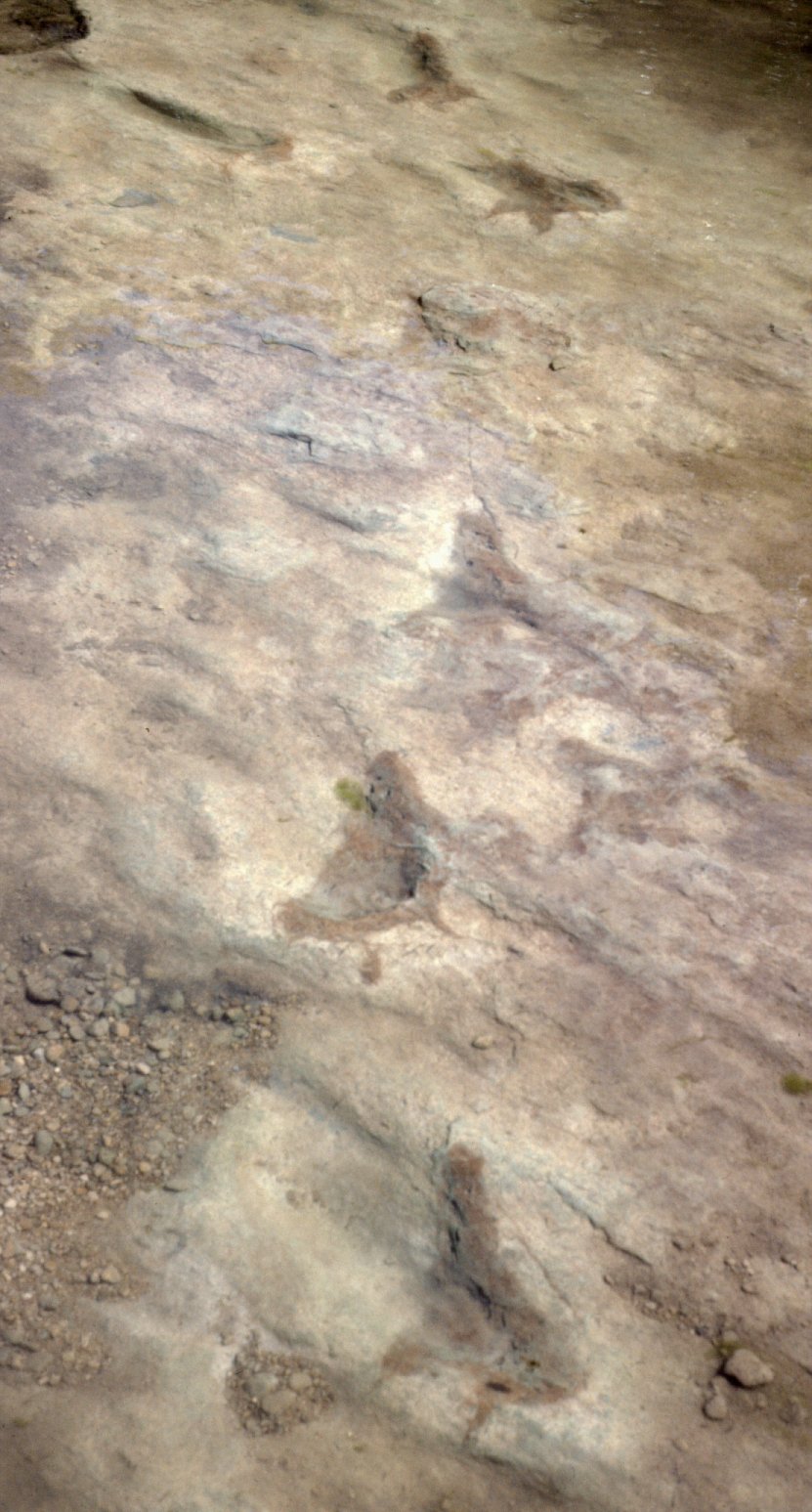 |
| Figure 6A. Track IIDW3, showing dramatic rust-brown coloration but little relief. The depressed area at the middle right is a feature shared by other tracks in the trail and may relate to the way the river flow acted on the infilling material. | Figure 6B. The western portion of the IIDW Trail, intersecting the Taylor (IIS) Trail at the upper right. Track IIDW1 at lower right. | Figure 6C. The eastern portion of the IIDW Trail, intersecting the Ryals trail at top. Note the continuation of the colorations through deep erosional undulations in the substrate (lower part of picture). |
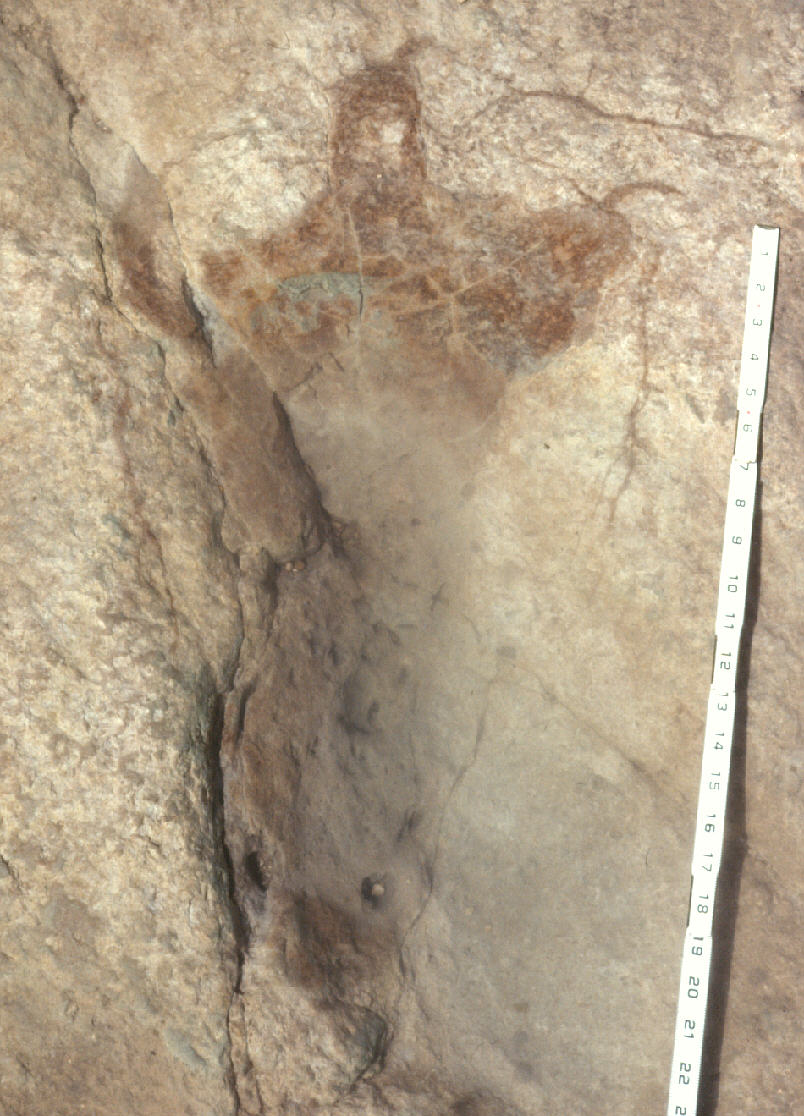 |
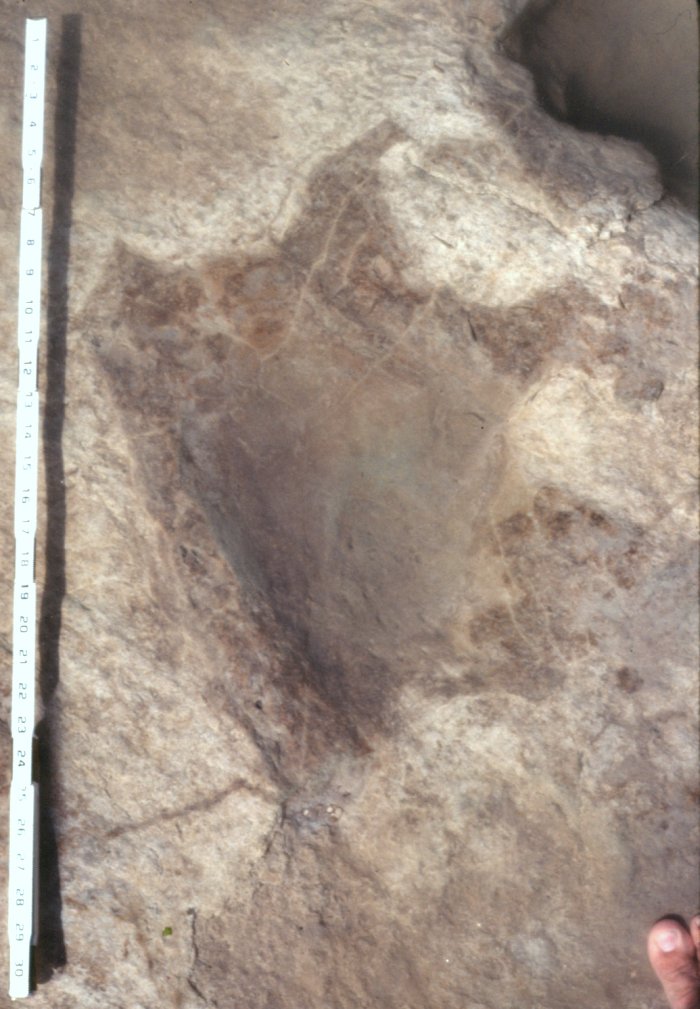 |
| Figure 6D. Track IIDW2, showing sharp claw marks. | Figure 6E. Track IIDW4, the only track in the IIDW trail not showing a full metatarsus. Two core samples were taken from this track (see Fig. 9). |
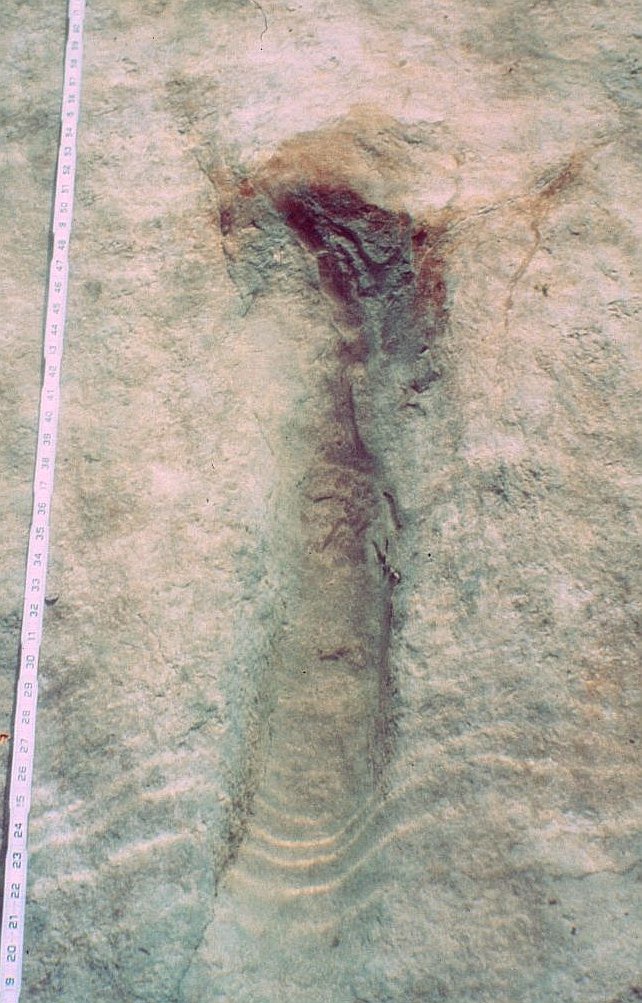 |
| Figure 7a. Ryals Trail. A. Track RY+4, an unusually long, narrow track (almost 1 meter long), probably representing a combination metatarsal track and slide. Following this track is a large hole reported to be the spot where a "man track" was removed by local resident Jim Ryals in the 1930's. Core samples were taken of the right and middle digits. |
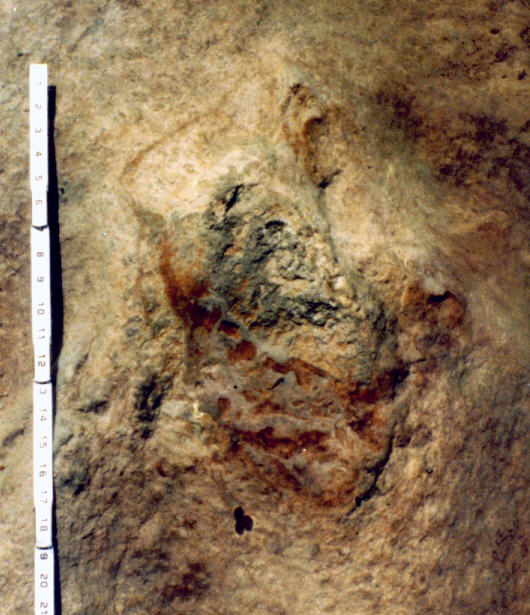 |
| Figure 7b. Ryals Trail track RY,-1, the only digitigrade track in the Ryals Trail, showing rust-brown color and raised relief. |
In September, 1986 Ron Hastings and I took small core samples from tracks IIS+4; IIS,-4; and GR,-1 (one core each); and RY+4 and IIDW4 (two cores each). Each core was taken at one of the digits, either straddling or just inside the coloration border, so that some of the "inside" and "outside" material was included in each core. The cores were drilled with a diamond-tipped bit and flexible extension shaft on a portable drill. A glass- bottomed aquarium was used to obtain a clear view of each track through shallow water while each core was drilled.
Only where the surface boundary between the inside and outside materials was somewhat indistinct or mottled was the subsurface border also somewhat indistinct or mottled, but even in these cases each dark area at the surface corresponded to a dark area under the surface. Thus, the gross appearance of the cores strongly supports the infilling model, and contradicts a compaction model or staining hoax (where deep and distinct subsurface borders matching the surface borders would not be expected). Fig. 9 shows where four of the cores were taken, and interprets them in terms of infilled tracks. Micro-analysis of the cores further supports the infilling model (discussed below).
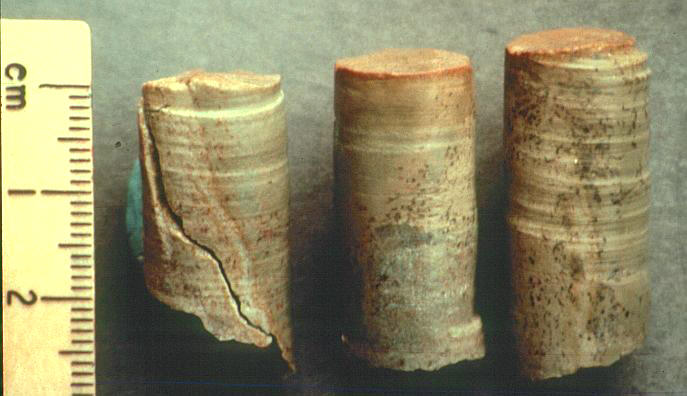 |
| Figure 8. Core samples. From left to right, the cores were taken from tracks IIDW, IIS,+4, and RY+4. |
With application of weak HCL, the outside material fizzed violently, whereas the inside material fizzed only weakly. This suggested that the outside sediment was highly calcitic, and the inside material more dolomitic, which was confirmed by thin section and X-ray analysis (discussed below). The microfossils were etched very deeply by the acid, suggesting that they were largely calcite, which also was confirmed by X-ray analysis.
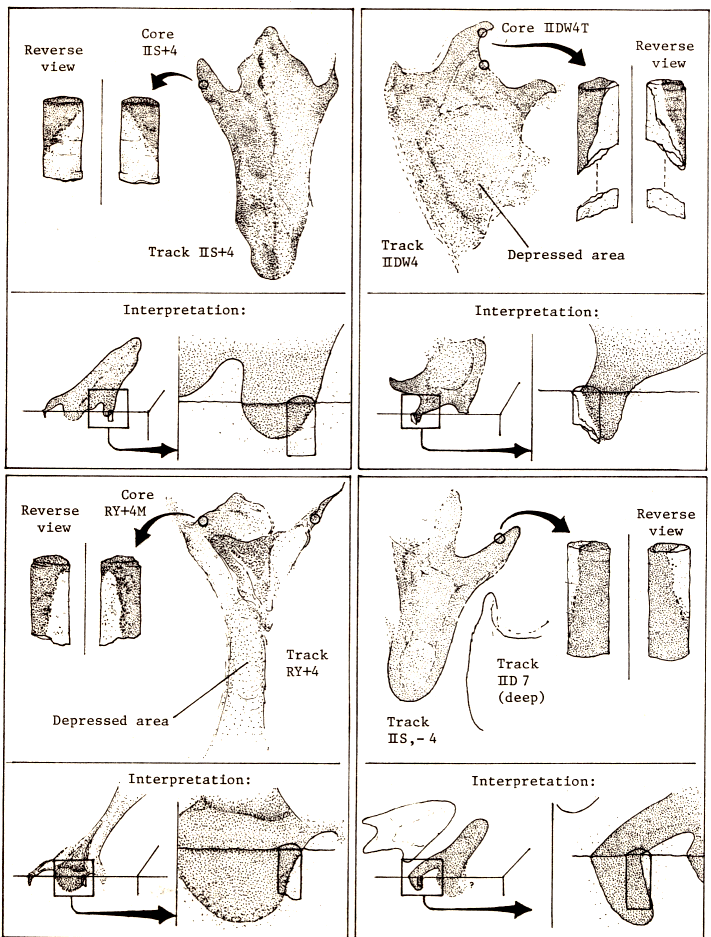
|
| Figure 9. Diagram showing the locations of 4 core sections taken by Ron Hastings and myself, and subsurface interpretations based on the core sample appearances and infilling model. The lower part of each drawing shows how each core relates to a hypothetical cross section of the track at the point where the core was taken. |
Augmenting the above work was an energy-dispersive scanning electron microscope analysis performed on core RY+4M by Scott Pluim of Tulsa, OK, which indicated the proportion of heavy elements in each area. The inside area was found to contain only a slightly greater percentage of magnesium than the outside material (14.7 inside vs. 10.9 outside), and almost identical percentages of calcium (47.9 vs 48.8). This does not necessarily conflict with the above X-ray diffraction results indicating a great difference in dolomite content, due to variations in the way the elements might combine. The X-ray analysis indicated little difference in iron content between the inside and outside areas, although the reading was taken well below the rusted surface. Thus, the propensity for the inside material to rust more than the outside material may relate to factors other than an inherent difference in iron content. The amount of rust on the inside material seems to be closely related to the degree of elevation (and thus the frequency of exposure to air), but the same does not seem to hold for the outside material (which is generally lighter in color even at the higher regions, and where rusted, shows little relationship to degree of elevation). It may be that the iron in the inside material is in a form that more freely oxidizes, or that the inside material more readily absorbs iron from the river water than the outside material.
The core analyses performed to date thus indicate that the inside matrix is essentially a finely crystalline dolomite, and the outside material is a more porous, less homogeneous limestone. These basic compositional differences add further support to the infilling model. However, more research is needed to determine why the surface of the inside material "rusts" more readily than the outside material; why it is softer than the limestone where not rusted; and even why it is bluish-grey (that it is more dolomitic does not in itself answer these questions). Small chips taken at the margin of track IIDW4 in 1985 were studied with an electron micro-probe analyzer at the University of Texas and found to contain some kaolin, iron pyrite, and celestite (Wann Langston, personal communication) but this study did not distinguish between the inside and outside material.
Complete cross sections of one or more tracks may further clarify the nature and history of the colorations, but this was not done initially in order to minimize damage to the tracks.
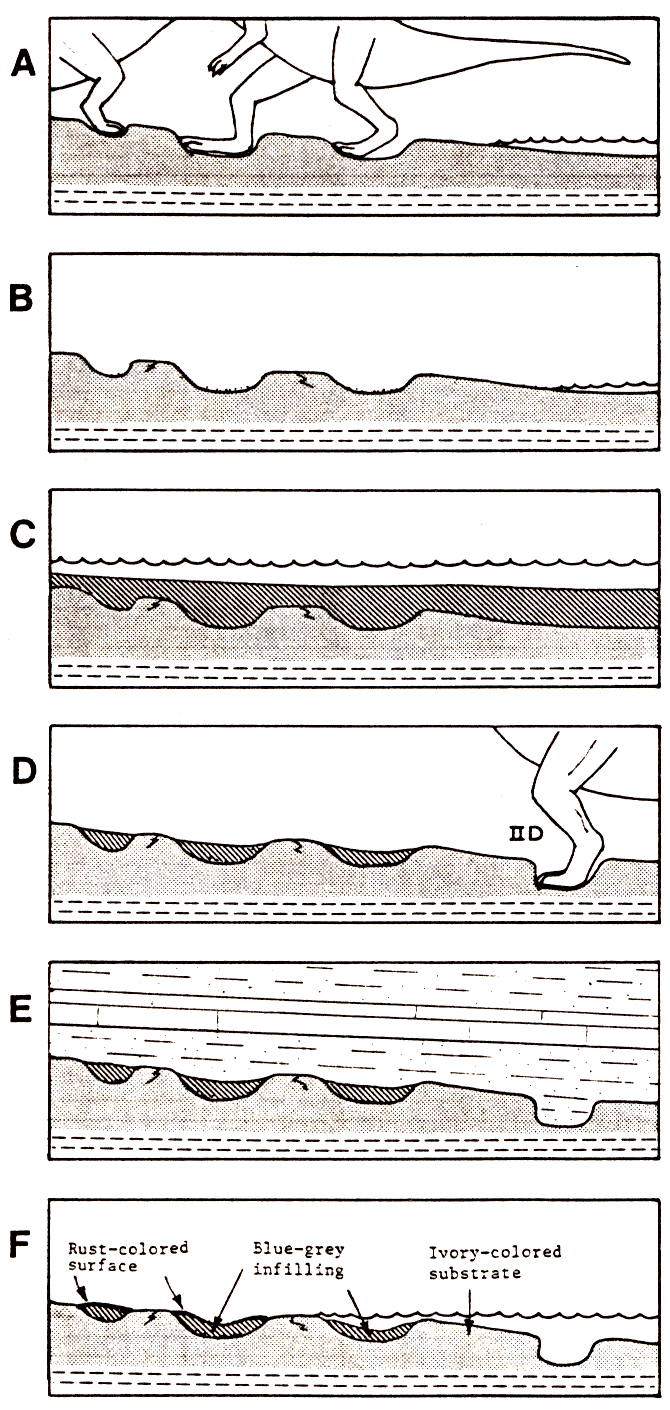
|
| Figure 10. A proposed sequence of events leading to the color and texture distinct tracks at the Taylor Site. Scenes A through E depict Cretaceous events; F is the current condition. A. Bipedal dinosaurs make tracks in moist carbonate mud. B. Possible period of partial dying. C. Influx of a secondary layer of fine grained sediment. D. If the deposition in scene C buried the endire site, a period of erosion probably took place, reducing the secondary layer to the depressions alone, leaving "infilled" tracks. A heavy carnosaur (IID) walked on the site while the substrate was still pliable, leaving deep, non-infilled tracks. E. Succession depositions of carbonate and carbonate/clastic sediments bury the entire site. F. The modern Paluxy River and human excavators remove the overlying strata, reexposing the infilled depressions. Exposure and weathering cause slight changes in track relief, and accentuate color and texture contrasts between the original substrate and infilling material. See text for further details of this model and possible variations. |
After the infilling (or infilling/erosion) event, the robust IID dinosaur may have walked on the site (D), accounting for the deep, non-infilled IID tracks (other possible explanations for the IID tracks are discussed below). Also after--or perhaps during--the infilling event, changes in water depth, water chemistry, microbial activity, and/or other factors may have fostered the dolomitization of the infilling material. A sandy clay then buried the entire site, followed by successive layers of other carbonate and clastic/carbonate sediments during the remainder of the Cretaceous (scene E). In modern times (F), the Paluxy River and human excavators reexposed the track horizon, revealing the largely infilled tracks. Recent river scouring then removed some of the infilling from some tracks or parts of tracks, while exposure and weathering caused the infilling surface of others to become rusted and hardened, creating some tracks with slight positive relief.
Variations beyond those discussed above, or alternate models, are also possible, but I consider them less likely. One possibility is that before the dinosaurs walked on the site the infilling to-be was already present in the form of a shallow layer of watery, fine-grained mud overlying a firmer base of lime mud; so that as the dinosaurs walked, the overlying material immediately flowed into the depressions. However, if this were the case, one would expect the color borders to be less distinct than those observed (due to partial mixing of the moist sediments). Another variation postulates a two-layered original substrate where both layers were firm but pliable. When the dinosaurs walked, both layers were depressed; the higher areas were later leveled off by erosion, leaving infilled tracks. However, it seems unlikely that the sediments could be soft enough to allow the upper layer to be pushed deeply into the lower layer and yet not distort the boundaries between the two materials (which would contradict the smooth, distinct borders seen in most cores). A more remote possibility is that a very soft layer occurred under a firm top layer; so that as a dinosaur stepped, its feet punched through the top layer to the soft underlying sediment, which welled up from below, filling the depressions.
A number of alternate explanations also may be proposed to account for the apparent lack of infilling in the deep IID tracks. As depicted earlier, the IID dinosaur may have walked after the infilling/erosion episode, at which time the infilling was already confined to the depressions on the site. Or, it may have walked before or during the erosional episode (while the secondary material covered the entire site), but if the secondary material at that time was shallow and firm, but pliable, the IID dinosaur may have pushed it down as its foot impressed, leaving the deep IID tracks. The bottoms of the IID tracks are bluish, but the coloration is less distinct than on other tracks, and may represent an underlying bluish clay rather than infilling. (Cores of the IID tracks have not been taken yet). Last, the present depth of the IID tracks might be due simply to their great initial depth, so that the infilling material filled them less completely than the other tracks.
Colorations unrelated to infilled material include black stains caused by humus and decaying vegetation which often accumulate in track depressions; green films of algae which may cover track surfaces in damp or submerged areas; and simple iron stains (on a single substrate), generally due to differences in frequency or degree of wetness. In most cases these superficial types of coloration are readily recognized as such, since they 1. Are often poorly defined, 2. Usually can be scrubbed off, 3. Do not reveal details of foot shape beyond the track depressions; 4. Except for algal coverings, generally show no texture contrast with the surrounding substrate, 5. Do not include "raised" tracks, and 6. Do not exhibit deep and distinct subsurface borders corresponding to the surface borders (as revealed by core samples or cross sections).
In some cases such colorations may occur along with (or on top of) infilling-related colorations (algae and humus stains often occur along with the deeper colorations at the Taylor Site), but careful inspection, and core samples if necessary, usually will allow one to distinguish among them. The development of rust color on the surface of some infilled tracks is evidently influenced by some of the same factors that produce rust color on infilled tracks (such as relative elevation and dampness), but on infilled tracks (at least those at the Taylor Site), the role of infilling material in selectively concentrating and delineating the rust color is very apparent. Further, such infilling-related colorations are visible even where the rust color is not present (as seen in the blue-grey tracks).
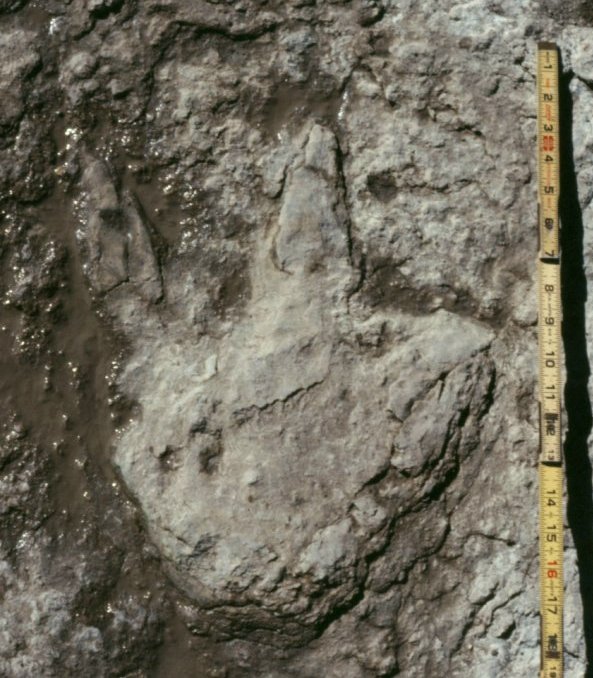
|
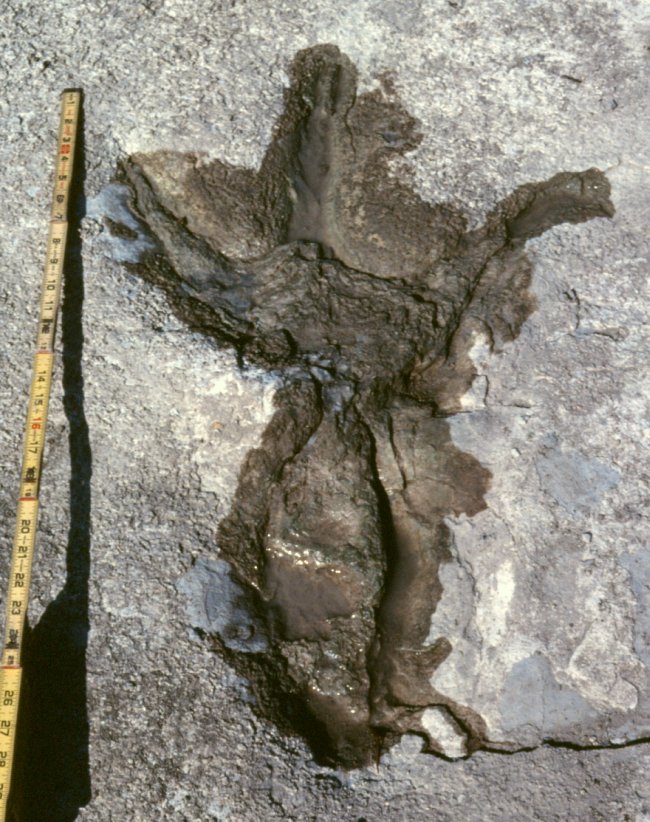
|
| Figure 11A. One of several tridactyl tracks with raised relief, located just west of the Taylor Site. This track did not show distinct colorations, but was not well scrubbed. | Figure 11B. Metatarsal track showing infilling, located about 300 m NE of the Taylor Site. Water was applied to accentuate the track features. Color contrast was not observed, but may have been obscured by algal crust that covered the track surface here. |

|
| Figure 11C. One of a trail of four infilled ornithopod tracks from the Alameda Parkway near Denver, Colorado, showing blue-grey to rust-brown coloration and slight positive relief. Photograph by James Farlow. |
It is possible that many additional color-distinct tracks exist, even on known track sites, but perhaps have been largely overlooked. On dry sites, any color contrasts would be reduced, and on wet sites colorations might be obscured by algal films or other superficial coverings. Track researchers are encouraged to clean track surfaces well (even in areas lacking depressions), so as not to miss any color distinctions that may be present, any new tracks or track features the colorations may reveal, and any clues to track formation and history they may provide.
Fields, Wilbur, 1980. Paluxy River exploration. Self-published, Joplin, MO., and personal correspondence, 1980-1982.
Kuban, Glen J., 1986. Review of ICR Impact article 151, Origins Research, 9(1):11-13.
Morris, John D., 1980. Tracking those incredible dinosaurs and the people who knew them. Creation Life Publishers, 240 pages.
Morris, John D., 1986. The Paluxy River mystery. Impact. 15(1).
Perkins, Bob F., and Wann Langston, Jr., (eds.), 1979. Lower Cretaceous shallow marine environments in the Glen Rose Formation: dinosaur tracks and plants, field trip guidebook, American Association of Stratigraphic Palynologists, 12th annual meeting, Dallas, revised 1983, 9-12, 49-52.
Taylor, Stanley, 1973. Footprints in stone (film). Films for Christ Association.
Taylor, Paul S., 1986. Footprints in stone: the current situation. Origins Research, 9(1):15.